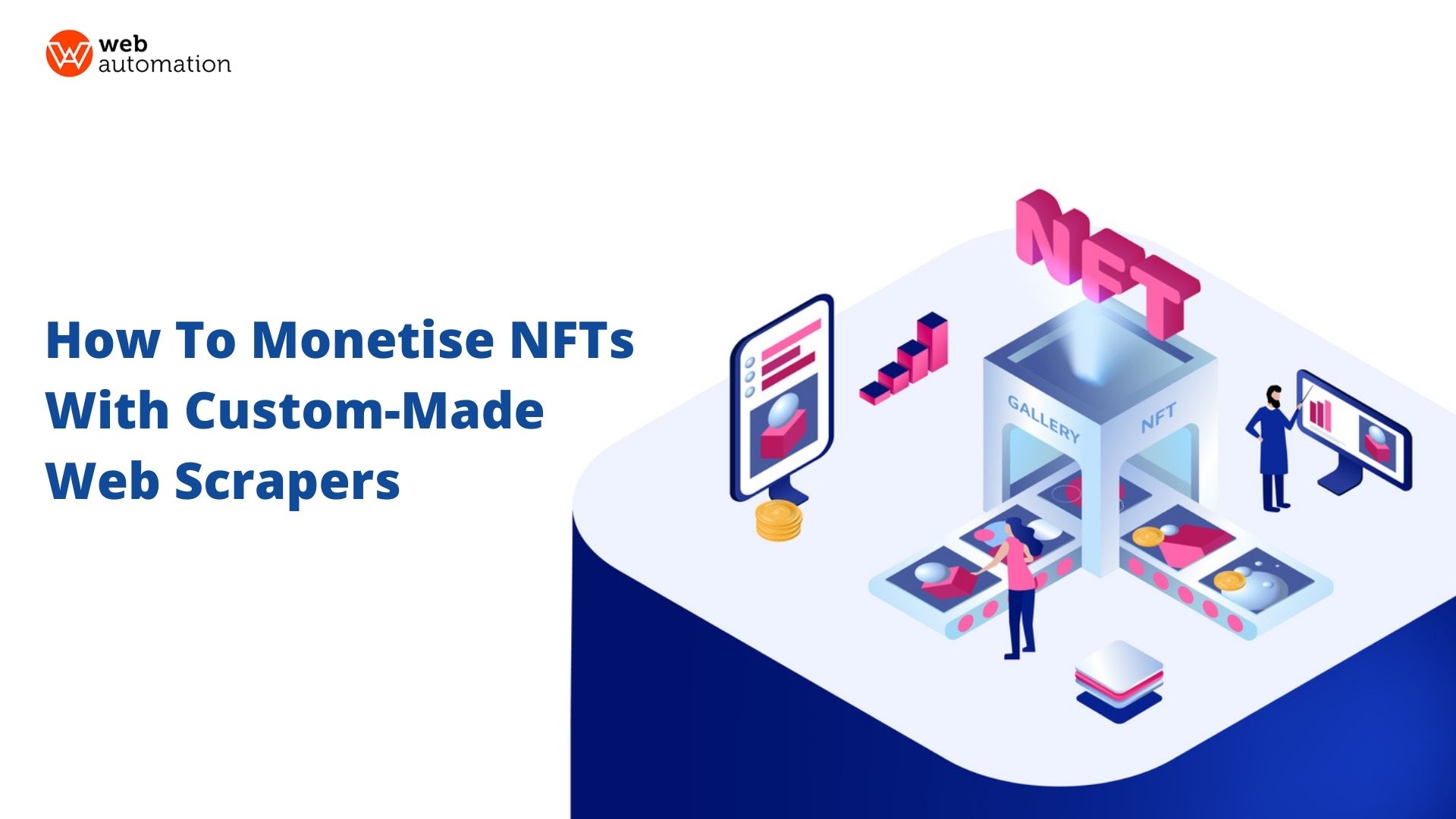
We are going to explain how you can use web scrapers to collect and analyze data about NFTs to help you make smarter investing decisions.
By Anmol @May, 27 2021

NFTs have been in the news a lot lately.
Many people are surprised and bewildered about how Tweets and gifs can be selling for tens and hundreds of thousands, and even millions of dollars.
Those who sense an opportunity, have one question in their mind:
How can I make money buying NFT's?
In this article, we are going to explain how you can use web scrapers to collect and analyze data about NFTs to help you make smarter investing decisions.
But first, let’s make sure we’re clear about what NFTs even are.
Non Fungible Tokens (NFTs) are digital tokens, used to represent ownership of unique items.
They allow us to tokenize assets such as videos, jpegs, real estate, and so on. They are protected by Ethereum Blockchain, which means at any given point in time, there can only be one owner of a particular asset. And no one can change the record or create a new NFT of the same asset.
An NFT is a cryptographic certificate of validity and integrity that you own something. It uses blockchain technology to maintain a track record of all purchases.
Just like you mint coins, you can now mint NFTs as well. You need to go to an NFT marketplace and upload your creation. Decide how many copies you want to make. The owner can then auction off the NFT in the marketplace. How much the NFT is sold depends on the value people perceive it to have.
A lot of creators and artists have taken up monetising their creations (digital artwork, music, videos, etc.) with the help of NFTs.
The more popular the artist, the more valuable the art will be. The lesser the number of copies, the more value each copy will be.
For example, the artist Beeple used an NFT to sell a piece of digital artwork, a jpeg called ‘Everydays - The First 5000 Days,’ for $69.3 million. Twitter CEO Jack Dorsey sold his first tweet for $2.5 million for a charity auction.
Making an NFT out of their digital artwork gives the creator a lot of control, but the true value is decided by the people who are willing to buy it.
There are a lot of advantages to investing in NFTs.
They are limited, hence valuable.
Unlike most assets, they are indivisible, if you don’t pay the full price for it, you will never be able to access it.
NFTs are extremely unique. They have a strong information tab that not only explains their uniqueness but also keeps the information safe and secure.
Another great benefit of investing in NFT is that they are easily transferable.
Used in blockchain technology make you certain that your NFT will be correct since counterfeiting in a decentralised and permanent system will be difficult.
Along with being uncommon, NFT offers transparency by being registered on a public ledger. Just the layer of security that people needed to safeguard the digital assets.
NFTs have become very popular to fight identity fraud and theft. College degrees, identity certificates, and dental records can all be digitised and converted into NFT.
Digital developers and content creators often face copyright issues. NFT is a great option to avoid counterfeit and validate one’s identity and claim to the work.
Digital assets like ETH domains are being widely bought using NFT.
Collectibles is perhaps the most famous uses of NFT to date. It’s a no-brainer that the rarer the object, the more valuable it is. NFT helps safeguard the original digital art piece and keeps the validity and ownership of any digital work intact.
NFT can even be used to buy physical properties in a digital marketplace, as they are a digital archive of real-world assets.
Right now, NFTs are in a nascent stage of growth and adoption. They are new and while they are gaining popularity very quickly, they are still far away from mass adoption.
NFTs, while a very lucrative option, have their fair share of risks.
If a person decides to buy an NFT but the seller declines or stalls, the rates will fall, leaving the buyer at a loss.
NFTs are not protected from frauds. Many times NFTs that have been sold for thousands of dollars were later discovered to be fraudulent.
NFTs can even be hacked based on how they are sorted.
Another risk that NFT carries is the reduction in quality, file formats becoming old and eventually obsolete and websites going offline temporarily or permanently and wallet passwords being lost or stolen.
To get involved in NFT purchases and investments, you will need a crypto wallet. This is a very important step, as the internet is full of fraudsters who could mint a piece of art they didn’t create.
Once you are on the platform, you need to scan through the various offerings. It can be confusing at first, but with enough experience, you can slowly see the patterns emerge. Some categories will be more expensive than others. A few pieces from the same category will demand a higher price than others.
While this may sound easy, spotting these patterns next to impossible since the data is rapidly changing and always evolving. At any given point, there are thousands of NFTs being uploaded and auctioned.
That’s where web scraping comes into play. An NFT web scraper will allow you to gather data at scale, which can then be analyzed to gain meaningful insights into how the NFT market is operating and evolving.
For example, with WebAutomtation’s pre-defined niftygetaway web scraper, you can scrape data like:
Volume of sales
Average price fluctuation of specific NFTs
Amount of traffic on the various NFT marketplaces
Money spent on a drop
(A drop refers to the uploading of a digital asset or an NFT onto the digital marketplace)
The number of drops in a day or even an hour to analyse if the time of the NFT release has any effect on its performance in the market.
Compare new drops to the creator’s following on social platforms like Instagram or Twitter
Note the date when the NFT was originally launched
The basic steps to scrape NFT data are:
Scrape websites like Niftygateway, Marketspalace, Opensea, and Rarible to collect data about the prices, availability, latest bids, etc.
You can then analyze this NFT data to look for products more than the average (secondary market sales) / (primary market sales) ratio, which is roughly 0.67
Between these products, get the cheapest priced NFT in the secondary market if the price is lower than the (average secondary market sale price), buy automatically
Now put the item on sale for the average secondary market price.
Web scraping can automate your process of keeping an eye on the ever-changing market. Regularly scraping NFT marketplaces will allow you to choose the NFT which are growing in value and thus make a profit later by selling them.
NFT market size has grown immensely and rapidly. If you are considering entering this market, getting as much data as possible will help you make more informed decisions.
Ready to get started? Create a free account today and activate our pre-defined niftygetaway web scraper.
No coding is required and with just a few clicks you can start scraping data on the NFTs you are considering for your next purchase.
Need more custom data from niftygateway? Reach out to us info@webautomation.io